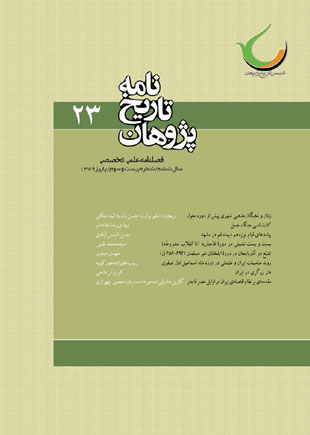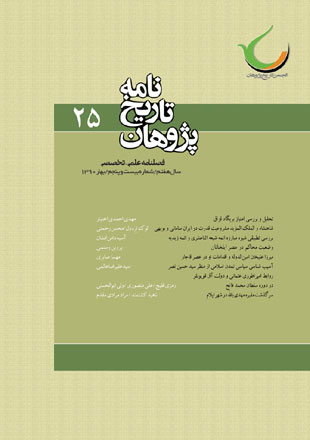فهرست مطالب

فصلنامه نامه تاریخ پژوهان
پیاپی 23 (پاییز 1389)
- بهای روی جلد: 30,000ريال
- تاریخ انتشار: 1389/10/11
- تعداد عناوین: 8
-
صفحه 22
-
صفحه 138
-
Page 4Translated into Persian by: Hasan Zandieh and Lida Maleki Historians of early Islamic Iran and of medieval Islamic education agree that women sometimes gained reputations for learning, just as they sometimes did for Sufi activities. The preservation of female names in biographical dictionaries of the tenth and eleventh centuries proves this point. The rarity of female names in these compilations raises a question, however. Why so few? This chapter examines the entries on women in biographical dictionaries from Baghdad, Nishapur, and Gorgan in an attempt to understand how their names came to be included and what broader social meanings might be inferred from their inclusion.
-
Page 22Documenting to the sources prior to and after a historical incident is very essential and natural. The event farmous as the battle of camel or Jange Jamal is no exception to this rule. It was a very strange event in the Islamic history in which for the first time two groups of Muslims confronted each other. Many historians have written on this event, however, except for Aljamal by sheikh Mofid all other sources have been lost. The book by Mofid is not at all a purly history book rather it is both historical and theological. Probably, the lack of proper sources is one of the reasons for the controversy of Muslims especially the theologians over the number of the participants and the people killed in this battle. Although there exist not many special sources over this battle, one mayrefer to general histories, geneologies and classes to discover the causes for these events. However, the general drawbacks of these sources over the battle are their ignorance of consequences of this battle and their ignorance of the analysis of it.The works of the theologians of various Islamic sects are among the sources which provide useful information over the Jamal battle. It must be said that the authors of these sources also have a great deal of controversy over the participants and those who were killed in this battle. Key terms: Ali (A. S), Jang-e Jamal (battle of the Camel), Companions of Jamal, Special Sources, descendents and the classes, Fotooh, GeneralSources, theological Sources.
-
Page 531356 was a year in which a great number of events happened in the history of the Islamic revolution. The death of Dr. Ali Shari’ati and Ayat-ullah Seiyed Mustafa Khomeini marked the beginning of this movement after a period of tranquility. These two events instigated the people and made them very angry. The regime which was very angry because the people loved these two men (Shariati and Seyed Mustaf Khomeini) published an article whose title was “Iran and black and red Colonialism) in Etellaat newspaper, to insult imam Khomeini and disappoint people of continuing their movement. This action led to general revolt of people in all parts of the country and especially the uprising in Qom on 19th of Deymah. The 40 – day memorization of the people killed in Qom in Tabriz and the 40 – day memorization of the victim of Tabriz in Yazd, Ahvaz and Jahrom became aproblem for the regime and paved the way for the general uprising against Pahlavid regime in all parts of the country. The above – mentioned events produced many results in Mashhad. Issuence of notes, making demonstrations, staying in the houses of Mullas,performing funerals were among the reactions of the people of Mashhad against these events. All these events made a step foreward for the movement of Imam Khomeini and made it closer to victory. The present study attampts to survey these events and consider the reactions of the religious leaders of Mashhad to these events.
-
Page 80In the history of Iran’s religious law system and the framework of Iran’s legal activities especially in recent governments religious refuge and its related subjects need a unique and independent research. The present study attempted to deal with the afore-mentioned subject through the examination of the documents and conducting a library research in the Qajar period to the emergence of the movement for constitution in Iran. The findings of this study indicate that during this period religious refuge was very widespread and a great number of places were used for this purpose. The refugees were mostly the run-away convicts or the oppressed. These refugees were more or less successful although this act didnot lead to their complete clearance from the charges or was not a way for the oppressed to obtain their rights completely. Some reformists attempted to exert some measures to limit religious refuge seeking, however, since this was an individual action their attempts werenot completely successful.
-
Page 96Coinciding with the establishment of the Ilkhanid government in Iran (656 A.H.) and on account of the placement of the central government in Azarbayejan, this province became the favorite place for the Shiites. The pressence of Khajeh Nasir Al-din Tousi (died 672 A.H.) in Azarbayejan who was a shiite scholar and very influential in the Ilkhanid government can be counted as a breakthrough of the shiite influence in this area. On account of the exellent situation wich Khajeh had among the Ilkhanid kings, especially Holaku Khan, he was able to defend the interests of the Shiites. He held endowments institutions and began to use the Shiites in this institution and promoted their conditions. At the same time, the great number of Shiites who had set for Azarbayejan on account of the benevolence of Khajeh could pave the way for the continual pressence of the Shiites in Azarbayejan.
-
Page 110With the reigning of Shah Ismael in Iran, the activites of the Sufis who adhered the Safavids increased in the Ottaman empire. Later on, on account of the revealing of their threat in political and military matters, Bayazid began to act against them and attampted to prevent their migeration to Iran. In addition to defending the propaganda of the Sufis in Eastern Antalia, Shah Ismael made some attacks upon the Ottoman lands to punish the Iranian rebels who had taken refuge there. The two kings were very severe upon their religious opponents and this action had some political and economic reasons however, they sent delegates to one another's courts and they both attempted to find adherents for themselves. During the reign of Salim (I), in addition to the continuation of the propaganda by the Sufis in the Ottoman land, a number of ambitious princes also fled to Iran, these events paved the way for serious challanges between the two rulers and finally led to Chaldoran war. Events like these made troubles for the two neighboring countries till the end of Shah Ismael's rule which coincided with the ruling of Soltan Soleiman. The present study deals with the relations between the two nations duringthe regin of Shah Ismael Safavid (I), and Bayazid (II), Salim (I) and Soltan Soleiman.
-
Page 138One of the important eras in Irani’s history as far as art and its aspects are concerned is the Safavid era. The existence of relative security, the fact that some of the Safavid rulers were artists and their patronage, along with the continual relation with the western and the eastern world were among the processes which were very important in this regard. The art of the goldsmiths is among the most obscure arts in the whole history of the country. The reason for this fact is that gold and silver have various usages and the melting and casting of golden objects can bring a great deal of harm to them by the passage of time. Never the less, goldsmith artists through their own special techniques played a very important role in the cultural and political life of the Safavid era. The present study, through employing a historical method attempts to probe into the place of the goldsmiths and their art in the social and cultural life of the Safavids.
-
Page 173Translated into Persian by:Mansoor Chehrazi and Mahboobeh Ahmadian This article is the substance of a paper read at the British Instilute of Persian studies, Tehran, on Saturday, June 29th 1963. In view of the jeneral neglect by historians of the economic history of Iran it is the aim of this article to examine some of the significant factors in the economic structure of Iran during the period betveen the death of Karim Khan Zand in 1779 and the Treaty of go Gulistan in 1813. These thirty-five years cover the period when Aghga Muhummad Khan overthrew all other contenders for mastery of the Iranian plateau and firmly established the Qaqjar dynasty on the peacock throne, as well as the first half of the long regin of his nephew, Fath’ Ali Shah.The principal sources for the economic survey which follows are the reports and personal impressions of some of the English travelers in Iran during this period. Although the accuracy of the facts recorded by these travelers naturally varies from individual tu individual, their value as sourcematerial (in view of the poverty of other sources of information) is very considerable. All of them spoke Persian in varying degrees of proficiency and a few were fluent readers of the language. Most of them spent severalmonths or, in some cases, several years in Iran. The majority were diplomats, soldiers or merchants of the East India Company who had-in Mysore, Hyderabad, or the outlying provinces of the Mughul or Ottoman empires-experienced societies not wholly dissimilar from that of late eighteens-century Iran. All were concerned with obtaining information for their employers and countrymen about a country, Iran, which was then comparatively little known to Europeans. With regard to the accuracy of their accounts of the economic life of Iran, it must be remembered that if, during this period, it was the supposed Oriental ambitions of Napeleon which were the immediate cause of british pre-occupation with Iran, the East India Company was still, at this time, a commercial corporation and therefore interested in Iran not only for strategic reasons but also as a potential market. It may therefor be safely assumed that the Company’s servants in Iran were expected to observe and record as accurately as possible the economic conditions of a country likely to be an area for future commercial expansion.


